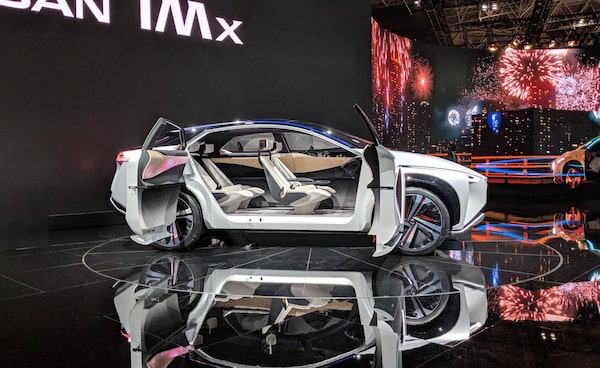
Nissan’s self-driving vehicle prototype is related to the IMx, a concept car it unveiled last week at the Tokyo Motor Show.PETER NOWAK/The Globe and Mail
Nissan is testing a new self-driving prototype car, with plans to commercialize the vehicle by 2020.
The car, which is currently driving on the streets of Tokyo after similar tests earlier this year in London and Silicon Valley last year, will be capable of full autonomy on both highways and urban streets, the Yokohama-based company announced at the Tokyo Motor Show last week.
The goal is to enable driver-supervised autonomy on city streets and intersections by 2020. Nissan is targeting full autonomy, in which the driver can take his or her hands off the steering wheel completely, around 2022.
The prototype makes use of a host of technologies, including nine radar sensors, six laser scanners, 12 sonar sensors and a dozen cameras positioned around the vehicle. The sensors construct a continuously refreshing real-time environment that the car's artificial intelligence then uses to navigate.
The upcoming 2018 Nissan Rogue, in comparison, doesn't have laser sensors and uses sonar only for self-parking, a function that won't be available in North America because of what the company says is a lack of demand. The Rogue also has only a forward-facing camera.
Some manufacturers, including BMW and Jaguar Land Rover, have discussed installing voice-activated AI assistants into cars to help drivers get a handle on their various functions, including media, navigation and climate control.
Nissan is considering the same approach, but executives are currently focusing more on using the technology to actually drive the car.
"This is still more of an engineering usage of artificial intelligence," said Takao Asami, senior vice-president of research and advanced engineering for Nissan, at a session with reporters in Tokyo. "That's our priority. I'm not sure we're going after that [interface aspect] right now."
The prototype builds on the company's existing steps toward self-driving, which began in earnest last year with the Serena.
Available only in Japan, the minivan was the first to feature Nissan's ProPilot technology, an enhanced form of cruise control that allows it to automatically maintain a set distance from the vehicle in front of it and stay in its own highway lane. While the car effectively drives itself, drivers still have to keep their hands on the steering wheel in case of emergency.
ProPilot was also added to the 2016 X-Trail crossover, but it will only become available in North America for the first time with the upcoming 2018 Rogue and electric Leaf models, both scheduled for the first quarter of next year.
In its first iteration, ProPilot was able to handle single-lane autonomous highway driving. The updated version will work across multiple lanes, Nissan says.
The self-driving prototype is related to the IMx, a new concept car that Nissan also unveiled last week. The sleek, futuristic vehicle features a panoramic curved dashboard display and wood-grain instrumentation panel, as well as eye-gaze tracking, gesture and motion detection and speech-recognition technologies.
The car's windshield also has built-in augmented reality capabilities, so computer graphics such as navigation and pedestrian detection can be projected directly into the driver's line of sight. The vehicle's steering wheel also retracts when the car's autonomous mode is activated, for good measure.
Despite their plans, Nissan and other car makers are still facing significant regulatory and technological obstacles in rolling out additional self-driving functions.
Unlike several other countries and U.S. states, Canada has only recently started to allow self-driving tests on its roads. The rollout of autonomous functions is, therefore, likely to be uneven across different territories.
"We just don't have the freedom to do what we want," Asami said. "There's no perfect market in this regard."
Self-driving cars will also need to connect wirelessly to city infrastructure in order to operate properly and that's a technological problem that has yet to be solved.
Whether it's satellite connectivity, existing 4G cellular or the upcoming 5G standard, which is expected to come into use around 2020, Nissan has yet to settle on which technology or standards to use.
"We need 100-per-cent connectivity – it's mandatory," Asami said. "But we don't have a universal answer to that."
The writer was a guest of the auto maker. Content was not subject to approval.
Shopping for a new car? Check out the new Globe Drive Build and Price Tool to see the latest discounts, rebates and rates on new cars, trucks and SUVs. Click here to get your price.
 Peter Nowak
Peter Nowak